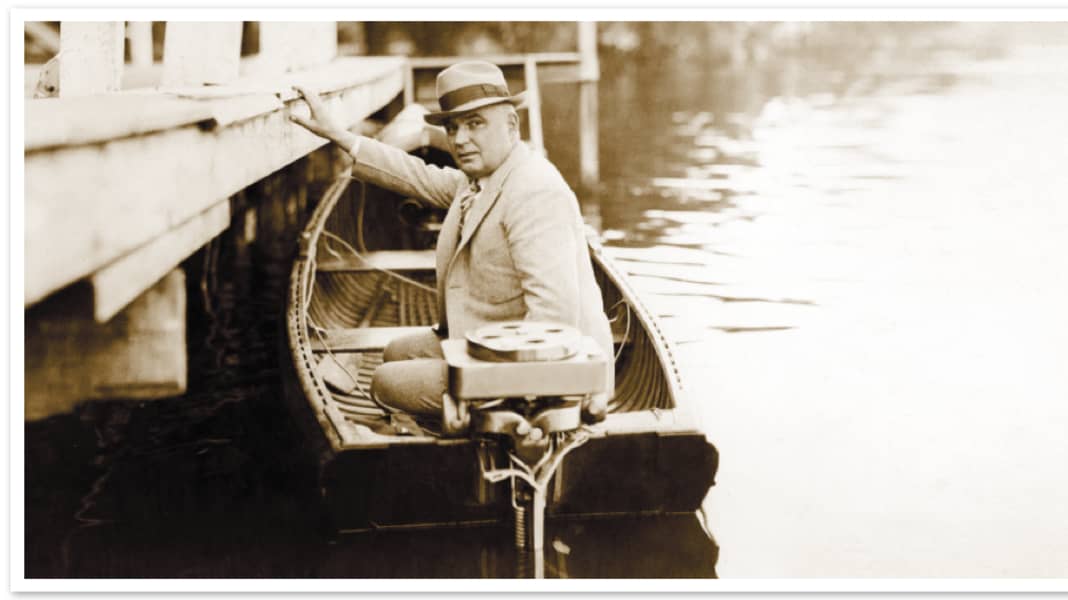
In Detroit, USA, Cameron B. Waterman was more successful 14 years later. The very next year, he sold 3,000 of his water-cooled 2 hp "Waterman Outboard Porto". The German term "Outbordmotor" presumably goes back to this American term.
In Europe, the Swedish brothers Alrik and Oskar Hult presented design drawings for an outboard engine, which they brought onto the market a little later under the company name "Archimedes". After various mergers of Swedish engine manufacturers, "Archimedes" ended up under the umbrella of Volvo Penta in (much) later times.
The small outboard engine invented by Ole Evinrude, which went into production in large numbers from 1910, was a resounding success worldwide. Evinrude's single-cylinder engine soon became well-known in Europe and was more or less creatively modelled on it. Berlin-based Fritz Ziegenspeck was successful in this endeavour, building the first German outboard engine in 1911, a single-cylinder that he called "FZ" for short.
The First World War stopped Ziegenspeck in his tracks, followed by inflation. In 1927, he sold his company to Andree Hauschild AG in Berlin, which added a ready-to-construct two-cylinder boxer engine to its production programme.
While everything initially centred on outboard engines, inboard engines gained momentum at the same time. After Rudolf Diesel "floated" a 25 hp diesel engine in Germany in 1903, four years later the Swede Edvard Hubendick presented his legendary B1 inboard engine. The ingenious lateral entrant later became a professor of combustion technology in Stockholm.
The internal combustion engine turned the maritime world upside down and Daimler had opened the door to a new world of motorboats with its tests on the Neckar. Even though Daimler did not even build a few boats at the time, it is well known that he ultimately focussed exclusively on building cars. Carl Benz also gave up his maritime hobby in favour of building cars.
Well, renowned shipyards all the way down to the small craftsmen recognised the recreational value of mobility on the water. But only very few managed to successfully enter the motorboat business.
One man, however, wrote the typical American success story that continued worldwide: Christopher Columbus Smith. In 1884, he founded a boatyard in Algonac together with his brother Hank and built and motorised duck hunter boats until Chris, Hank and his eldest son Jay installed a 2 hp Sintz engine in one of these boats in 1896.
The engine was practically a crutch until Charles Sintz came along two years later with a thing he called a carburettor. That was the breakthrough. From then on, the Chris Craft clan built the fastest boats in the world. The first motorboat ran at around 16 knots.
However, 30 km/h was not yet a speed for adrenaline rushes. With the idea of building super-fast hydroplanes, Chris Smith became famous not only in his home country. His most loyal customer remained the world speed record holder Gar Wood, who achieved 201 km/h with a hydroplane in 1932.
Chris-Craft, a name that Chris' son Hamilton came up with, was actually only founded in 1922 with the construction of normal pleasure craft and participation in the NY Motor Boat Show with three mahogany boats. But just seven years later, the shipyard was already building industrial boats. The assembly line production modelled on that of car king Ford made it possible to offer ten runabouts and six sedan models on the market. And with 95 models, Chris-Craft was already the world's leading shipyard with series models in 1937.
No competitor also had a dealer network and service centres from the USA to Europe. After the Second World War, CC went the way of many large family businesses when the patriarch dies. When the numerous Smith descendants' ideas about the shipyard's purpose and continued existence diverged widely, they sold up and the decline was heralded. Today, Chris-Craft is one of many suppliers and thus far removed from its original significance.
And what was happening in Germany at the same time?
PART 3 will follow. However, you can already watch the entire report in the current July issue of BOOTE which is now available at newsagents.

